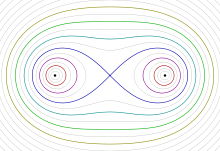Cassini's Ovals and Geometric Optimization
What is this about?
Problem
Elsewhere we considered a problem from the 2009 Asian Pacific Mathematical Olympiad:
Consider all the triangles ABC which have a fixed base BC and whose altitude from A is a constant h. For which of these triangles is the product of its altitudes a maximum?

It was noticed in the comments by Maurizio Frigeni that the solution was incomplete. Below we have a second look at the problem.
Hint
The problem is of geometric optimization. As is often the case, it is useful to consider level curves of the function involved.
Solution
Assume the two given points are $A(-a,0)$ and $B(a,0),$ for a parameter $a.$ It is helpful to find the loci of a point $P(x,y)$ the product of whose distances to $A$ and $B$ is constant, say, $b^2$:
$[(x+a)^2+y^2][(x-a)^2+y^2]=b^4.$
The so defined curves are known as Cassini's ovals and their shape depends on the ratio $e = b/a.$ A point on one of Cassini's oval will solve the given problem if and only if the given line $r$ is tangent to the oval at that point.
Here's how Cassini's ovals look like:

For $e = b/a \gt 1$ the curve is indeed a closed loop. When $e \lt 1$ the "oval" consists of two disjoint pieces. Finally, when $e=1$ the curve is intersects itself and looks like the symbol of infinity, $\infty.$ This one is known as the Lemniscate of Bernoulli.
For a fixed $a,$ Cassini's ovals cover the plane and do not intersect. Some of them are convex, others are not. In the given problem, $r\parallel AB.$ It may therefore happen that $r$ is tangent to a non-convex oval:

and then the olympiad problem would have two solutions. When does this happen? The answer to that is when $e \lt \sqrt{2},$ which corresponds to the case where $\mbox{dist}(A,BC)\lt BC/2,$ as was claimed by Maurizio Frigeni.

The emergence of the circle $x^2+y^2=a^2$ through the foci $B$ and $C$ is explained by implicit differentiation of the equation of the ovals. Assuming $y'=0,$ i.e., the points where the tangent to the curve is horizontal leads exactly to that circle. Before you differentiate it's worth to convert the equation to a different form:
$(x^2+y^2+a^2)^2-4a^2x^2=b^4.$
In his comment Maurizio asked about the case where $r \not\parallel BC.$
In this case, unless $r$ passes through the origin, the solution is unique:

If $r$ passes through the origin, there are two solutions when $e\lt 1:$

Acknowledgment
The graphics of the family Cassini's ovals are courtesy of wikipedia and wikimedia commons.
![]()
|Contact| |Front page| |Contents| |Geometry|
Copyright © 1996-2018 Alexander Bogomolny73608593
